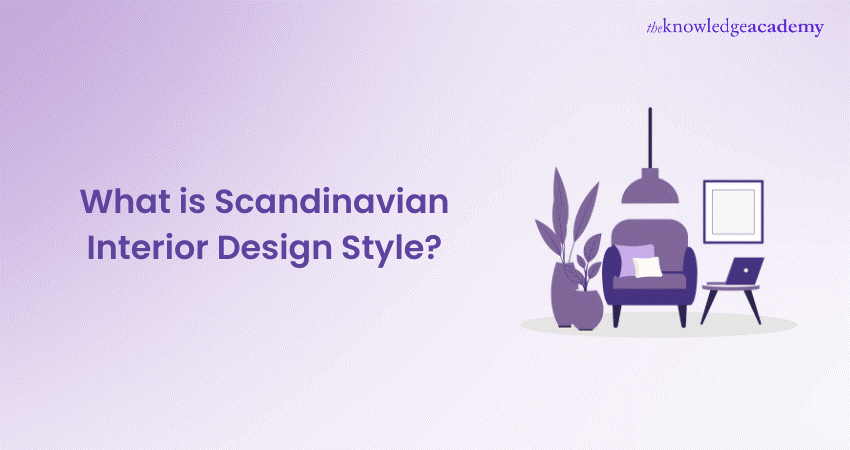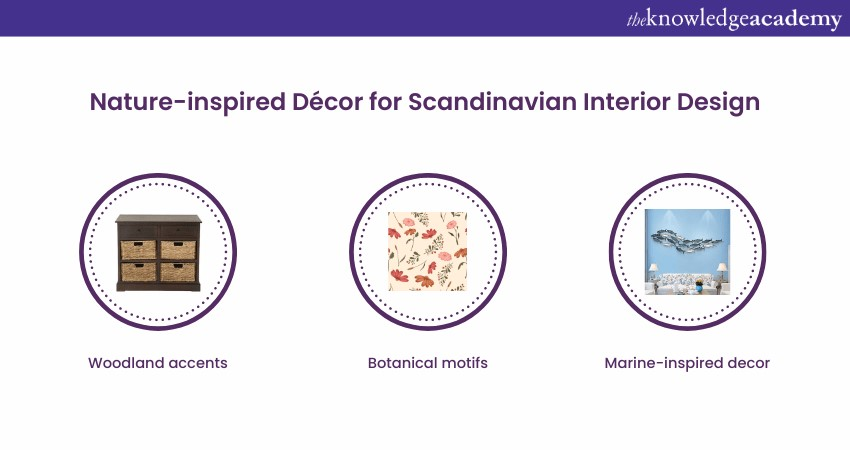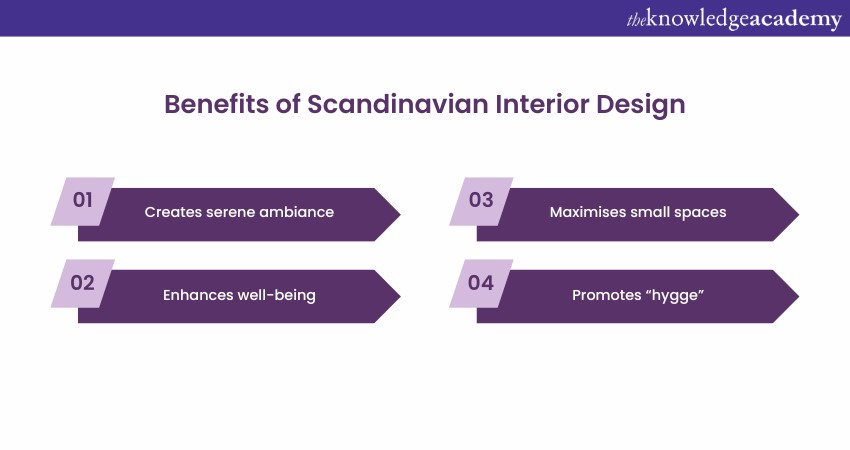We may not have the course you’re looking for. If you enquire or give us a call on 01344203999 and speak to our training experts, we may still be able to help with your training requirements.
Training Outcomes Within Your Budget!
We ensure quality, budget-alignment, and timely delivery by our expert instructors.

Scandinavian Interior Design is deeply rooted in the serene landscapes and cultures of the Nordic region. It has captivated the world with its unique blend of minimalism, functionality, and warmth. Hailing from Denmark, Norway, Sweden, and Finland, this design philosophy celebrates simplicity, natural elements, and a focus on crafting inviting and cosy living spaces.
With such a dynamic history, today, it stands as one of the favourites among people. In this blog, you are going to learn all there is to know about Scandinavian Interior Design, its key elements, and the benefits. Delve in to learn more!
Table of Contents
1) What is Scandinavian Interior Design?
2) Key elements of Scandinavian Interior Design
a) Furniture and materials
b) Textiles and fabrics
c) Lighting
d) Nature-inspired décor
3) Benefits of Scandinavian Interior Design
4) Conclusion
What is Scandinavian Interior Design?
Scandinavian Interior Design is a distinctive interior design philosophy that originates from the Nordic countries of Denmark, Norway, Sweden, and Finland. It embraces a harmonious fusion of minimalist aesthetics, functional design, and a deep appreciation for nature's beauty. At its core, Scandinavian Design is characterised by its emphasis on simplicity, clean lines, and uncluttered spaces, creating an atmosphere of tranquillity and visual equilibrium.
In this design, every element – from furniture and materials to colour palettes and décor is unique. Natural materials like wood, stone, and leather are woven into interiors, connecting indoor spaces to the serene landscapes outside. Light and neutral colour schemes amplify the sense of lightness and spaciousness. It's cosy textures and layers evoke a feeling of "hygge," or a feeling of comfort, contentment and well-being.

Key elements of Scandinavian Interior Design
To help you better understand about Scandinavian Interior Design, these key elements will help you:
Furniture and materials
Furniture and materials play a pivotal role in Scandinavian Interior Design, as they contribute to the aesthetic and functional essence of this style. The choice of materials and the design of furniture reflect the philosophy of simplicity, comfort, and a deep connection to nature. Here's how furniture and materials contribute to the charm of Scandinavian design:
1) Natural materials: Scandinavian design celebrates the beauty of nature. Furniture is often crafted from natural materials like wood, particularly light woods such as pine, birch, and oak. The inherent warmth and texture of wood infuse spaces with a cosy ambience.
2) Clean lines: Furniture design follows clean lines and minimalistic forms. Uncomplicated shapes and functional designs highlight the principle of less-is-more, creating a sense of visual harmony.
3) Functionality and practicality: Scandinavian furniture serves a purpose beyond aesthetics. Pieces are designed to be practical and efficient, contributing to the overall functionality of a space. Multi-functional furniture is especially favoured in smaller living spaces.
4) Timeless elegance: The furniture's understated elegance and enduring quality ensure that it remains relevant and appealing through changing trends, contributing to the timeless appeal of Scandinavian design.
5) Contrast and balance: Furniture pieces often showcase a balance between light and dark elements, enhancing visual contrast. Darker furniture against a light background creates a striking yet balanced composition.
6) Modernist influence: Scandinavian design draws inspiration from modernist design principles, focusing on functionality, simplicity, and the beauty of raw materials.
7) Incorporation of metal and glass: While wood is prominent, metal and glass accents are also utilised to add contrast and contemporary flair. Metal legs on chairs or glass tabletops offer modern touches to classic designs.
Want to unlock your AutoCAD potential? Register now for our AutoCAD Training.
Textiles and fabrics
Textiles and fabrics are integral components of Scandinavian Interior Design, adding warmth, texture, and a touch of cosiness to the clean and minimalistic aesthetic. These elements play a crucial role in softening spaces, enhancing comfort, and creating a sense of inviting charm. Here's how textiles and fabrics contribute to the allure of Scandinavian design:
1) Natural fibres: Scandinavian design favours natural textiles like wool, cotton, and linen. These materials offer richness and connect interiors to the region's natural landscapes, echoing the theme of harmony with nature.
2) Soft textures: Textiles such as throws, cushions, and rugs introduce softness and visual interest. Knitted blankets, plush cushions, and tactile rugs invite a sense of touch and comfort.
3) Layering: Layering textiles adds depth and dimension to spaces. A mix of textures, such as combining a chunky knit blanket with a smooth linen cushion, creates a visually appealing and cosy environment.
4) Subtle patterns: While Scandinavian design is known for its minimalism, subtle patterns like simple geometric prints or gentle stripes can be incorporated through textiles to add visual intrigue.
5) Neutral tones: Textiles often maintain the neutral colour palette typical of Scandinavian design, with whites, greys, and muted pastels creating a soothing and cohesive atmosphere.
6) Function and beauty: Textiles serve both functional and aesthetic purposes. They offer warmth during chilly Nordic winters while also contributing to the overall décor scheme.
7) Drapery and curtains: The lightweight sheer drapery lets in ample natural light, adhering to the design's emphasis on light and space. Simple curtain designs maintain an uncluttered feel.
Lighting
Lighting is a cornerstone of Scandinavian Interior Design, serving as a fundamental element that shapes ambience, functionality, and visual appeal. Given the region's extended dark winters, lighting plays a crucial role in creating a well-lit, inviting, and cosy atmosphere. Scandinavian design utilises a balanced mix of natural and artificial light sources to enhance the overall aesthetic. Here's how lighting contributes to the allure of this design philosophy:
1) Abundance of natural light: Scandinavian interiors often feature large windows that maximise the entry of natural light. The design celebrates the changing natural light throughout the day, reflecting the connection to the environment.
2) Light colours and surfaces: Light-coloured walls, ceilings, and furniture amplify the reflection of light, creating an airy and spacious feel even in compact spaces.
3) Minimalistic light fixtures: Lighting fixtures in Scandinavian design are marked by their minimalistic and functional designs. Pendant lights, floor lamps, and wall sconces emphasise clean aesthetics.
4) Layered lighting: Layering different light sources—such as ambient, task, and accent lighting—adds depth and dimension to spaces. Floor lamps and table lamps contribute to a warm and inviting atmosphere.
5) Candlelight and warmth: Candles are often incorporated for their soft glow and ability to infuse spaces with a sense of cosiness and intimacy. So, it aligns with the concept of "hygge."
6) Statement fixtures: While minimalism is a hallmark, a strategically placed statement fixture can serve as a focal point, adding an artistic touch to the design.
7) Function and mood: Lighting is designed with both function and mood in mind. Bright task lighting aids practical activities, while softer, ambient lighting enhances relaxation and well-being.
Nature-inspired décor
Nature-inspired décor is a vital aspect of Scandinavian Interior Design. It pays homage to the region's breathtaking landscapes – while infusing interiors with a sense of calm and connection to the outdoors. This element highlights the design's core principle of harmony with nature, contributing to a serene and visually appealing ambience. Here's how nature-inspired décor enriches the charm of Scandinavian design:

1) Botanical motifs: Prints, patterns, and artwork featuring botanical elements like leaves, branches, and flowers bring the beauty of nature indoors, adding a touch of freshness and vitality.
2) Natural materials: Incorporating natural materials like stone, wood, and jute amplifies the organic feel of Scandinavian interiors, reminding inhabitants of the serene outdoors.
3) Indoor plants: Greenery plays a prominent role in Scandinavian design, promoting a sense of well-being and purifying indoor air. Potted plants, succulents, and hanging planters infuse vitality.
4) Woodland accents: Nature-inspired accents, such as antler motifs or wooden sculptures, evoke a rustic charm that mirrors the Nordic wilderness.
5) Earthy colour palettes: Earthy hues like shades of green, brown, and muted blues echo the landscapes, creating a soothing and grounded atmosphere.
6) Natural textures: Textures reminiscent of natural elements, such as woven baskets, rattan furniture, and woollen throws, evoke a connection to the outdoors.
7) Oceanic elements: In coastal Scandinavian regions, nautical accents like shells, driftwood, and maritime-inspired décor can evoke a sense of seaside tranquillity.
Want to elevate your 3D design skills? Register for our 3DS Max Training today!
Benefits of Scandinavian Interior Design
The Scandinavian Interior Design philosophy offers a multitude of advantages that resonate with modern living, they include the following:

1) Creates serene ambience: The emphasis on minimalism, light colour palettes, and uncluttered spaces fosters an atmosphere of tranquillity, promoting relaxation and peace of mind.
2) Enhances well-being: The cosy textures, natural materials, and connection to nature contribute to an environment that supports emotional well-being and physical comfort.
3) Maximises small spaces: Scandinavian design excels in making the most of limited square footage. Clean lines and multi-functional furniture optimise space, creating an illusion of spaciousness.
4) Timeless appeal: The classic yet contemporary aesthetics of Scandinavian design ensure its relevance across changing trends. This makes it a sustainable choice that withstands the test of time.
5) Promotes “hygge”: The concept of "hygge," which encapsulates cosiness and contentment, enhances the sense of comfort and belonging – enriching the overall living experience.
Conclusion
To sum it up, the philosophy of Scandinavian Interior Design emerges as a one-of-a-kind design. This design philosophy harmonises function, aesthetics, and well-being. With its reverence for nature, minimalism, and the art of cosiness, this design offers a serene sanctuary where modern life and nature seamlessly coexist.
Want to empower your civil design projects? Sign up for our Civil 3D Training.
Frequently Asked Questions

Here are some aspects that you need to consider for Scandinavian Interior Design:
a) Natural light
b) Neutral and muted colours
c) Clean lines
d) Hygge
e) Natural materials

Scandinavian design is often confused with Nordic design. Even though Nordic design consists of Iceland, Finland, and Denmark, there are still subtle differences between each of these designs.

The Knowledge Academy takes global learning to new heights, offering over 30,000 online courses across 490+ locations in 220 countries. This expansive reach ensures accessibility and convenience for learners worldwide.
Alongside our diverse Online Course Catalogue, encompassing 17 major categories, we go the extra mile by providing a plethora of free educational Online Resources like News updates, Blogs, videos, webinars, and interview questions. Tailoring learning experiences further, professionals can maximise value with customisable Course Bundles of TKA.

The Knowledge Academy’s Knowledge Pass, a prepaid voucher, adds another layer of flexibility, allowing course bookings over a 12-month period. Join us on a journey where education knows no bounds.

The Knowledge Academy offers various AutoCAD Courses, including Interior Design Course, Mudbox Training, and AutoCAD Electrical Training. These courses cater to different skill levels, providing comprehensive insights into Interior Design methodologies.
Our Office Applications blogs cover a range of topics related to Interior Design, offering valuable resources, best practices, and industry insights. Whether you are a beginner or looking to advance your Interior Design skills, The Knowledge Academy's diverse courses and informative blogs have you covered.
Upcoming Business Skills Resources Batches & Dates
Date
 Interior Design Course
Interior Design Course
Fri 3rd Jan 2025
Fri 7th Mar 2025
Fri 2nd May 2025
Fri 4th Jul 2025
Fri 5th Sep 2025
Fri 7th Nov 2025







 Top Rated Course
Top Rated Course


 If you wish to make any changes to your course, please
If you wish to make any changes to your course, please


